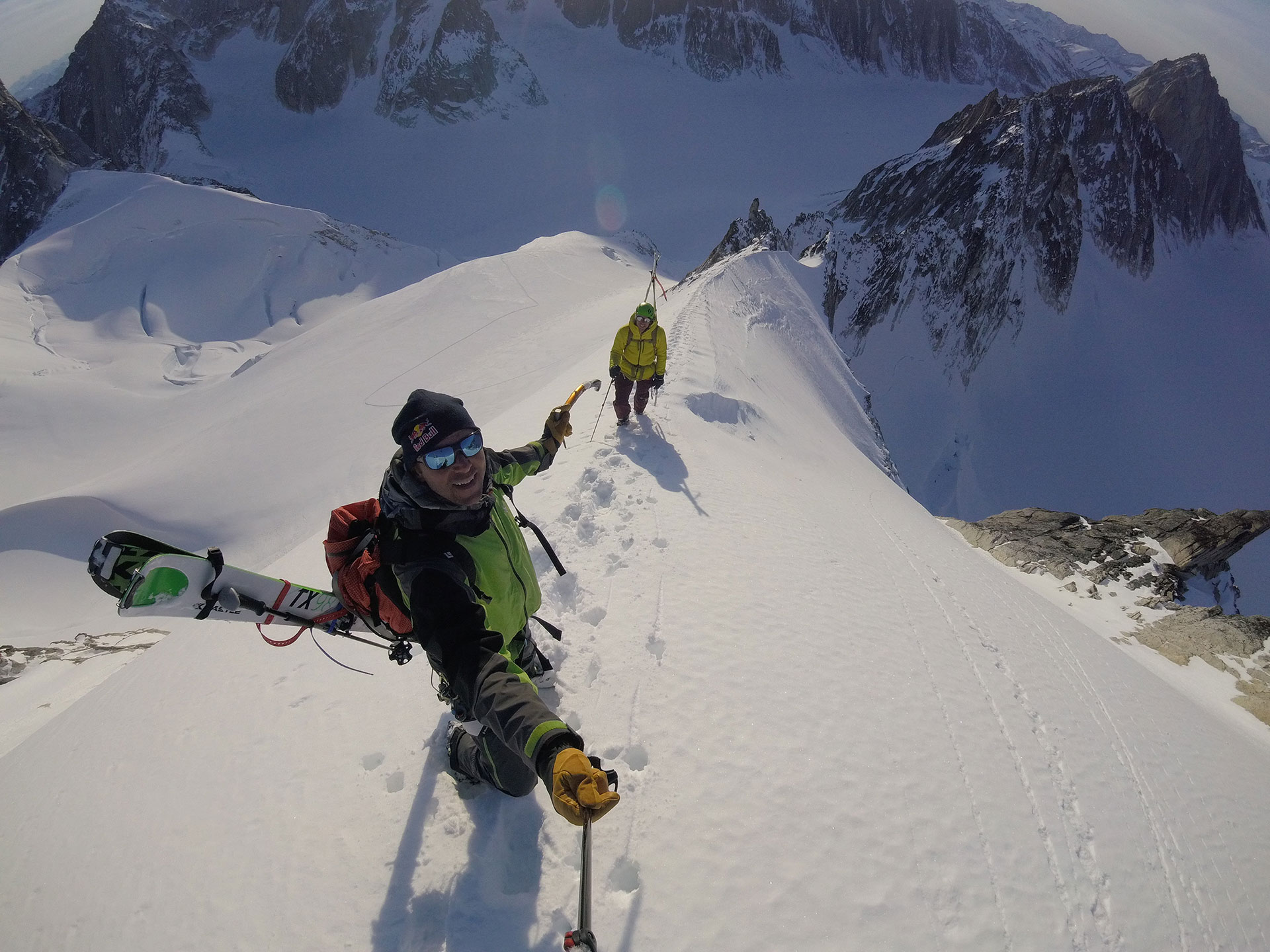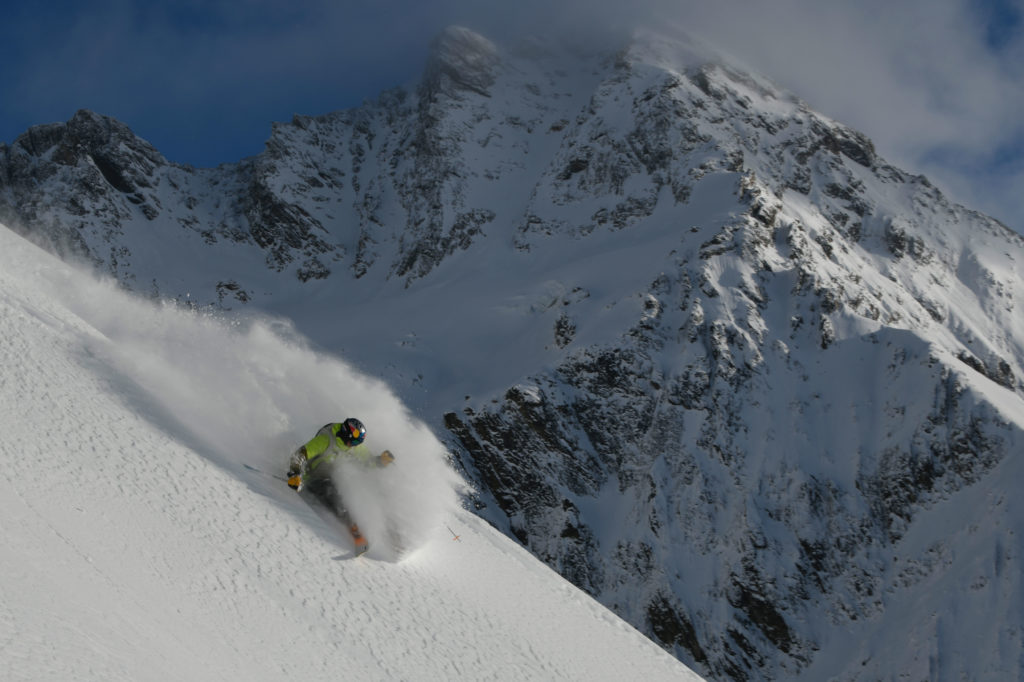- January 15, 2020
Tags
How Dav Stays Alive
Chris Davenport has become one of the most important skiers of our time. A former alpine racer, he won the world extreme skiing championships twice, appeared in countless ski films, was the first to ski all of Colorado’s 14ers in a year, has claimed first descents all over the world, and is the athlete face of climate change organization Protect Our Winters. He has also been incredibly savvy about marketing all of it, turning his name into a powerful brand.
But perhaps the most notable accomplishment on his resume is that, Davenport, 49, is still alive. How has this man, who by any measure has been in the crosshairs his entire career, escaped the fate that has claimed so many?
“There’s no substitute for experience,” he said during a recent phone interview from Aspen Mountain, where he was skiing with kids from the local race team. “You have to get your hands dirty.” It’s not lost on me Dav, as he’s known in the industry, answered the question as to why he’s not dead as succinctly as if I’d asked him how his day was. Which is perhaps more illustrative than the answer itself.

considers himself to be more of a risk manager than a pro skier.
When I first met him 15 years ago, working at the offices that housed SKI and Skiing magazines and Warren Miller Entertainment, I was struck first by how encouraging he is—as though a love of skiing is an ember meant to be stoked in everyone he meets. He has a relaxed confidence and a boyish smile, but underneath it hums an intensity that clearly drives him. And even when he’s standing in a hallway wearing jeans and sneakers, he can’t help but still be a skier—his body continuously conveys the compact, precise, and efficient skiing style he has become known for.
Dav first started backcountry skiing in the 1990s, after he quit ski racing at the University of Colorado in Boulder, Colo. He grew up climbing and backpacking around New Hampshire with his family, and combining his passion for the mountains with his passion for skiing was the natural next step. “Being the academic I was, I took my level one and two avalanche courses and I loved it. I never realized how much there was to learn.”
At that time, Dav was in an elite category of vulnerability: He was an extremely high-level skier with very little backcountry experience. “You can get yourself into dangerous situations just from having confidence. At the world comp in Valdez in ’96, I had the attitude that it wouldn’t happen to me. Looking back, I am amazed I survived the gauntlet of my 20s.”
Then in 1999, when he was in Chamonix filming for Matchstick Productions’ Global Storming, he realized just how dangerous that confidence can be. He was with an all-star cast—Wendy Fisher, Dean Cummings, Seth Morrison, Christian Pondella, and MSP owner Murray Wais—taking advantage of the first sunny day after a three-foot storm. They started early, filming in what Dav calls “pretty aggressive terrain” near the peak of Le Brévant. As the sun and temperature rose, the group intuitively felt that the conditions were changing, and they regrouped in a safe zone about halfway up a massive face they had just skied the previous run. As they discussed their options, a group of snowboarders came up 1,500 vertical feet above them near their tracks.
“One of them hit this cliff and when he landed, he released the entire slope, our tracks included,” he said. “The avalanche was huge. It came ripping right past us, within 20 or 30 feet of us, and I remember the sound was like a freight train. It was loud and aggressive and scary. We froze—it was the biggest avalanche any of us had been close to.”
Within 10 seconds, another snowboarder in the group came down to them and asked if they’d seen his friend emerge. They had not. There was a no-fall cliff zone beneath them, so they skied around it through the trees. Dav skied a couple of thousand vertical feet as fast as he could to the massive pile of debris.
“I was first on the scene. I found him,” he said. “He was very dead. His jacket had been ripped off… We called the heli and sat on the sidelines watching the rescue personnel do their thing. We skied off with our tails between our legs. It was an incredible wake-up call. We made a good decision, because we chose to get out of there, but to see that happen right in front of us was a very valuable experience. It certainly hammered home what could happen.”
It was a turning point for him in both his mindset and his career—and the lessons he learned that day still guide his day-to-day operation in the mountains. “We had the information we needed to make that decision,” he said. “The sun was out, the temps were warming up… Mother Nature doesn’t hide things from us. Everything we need to know is in front of us in plain sight, but it’s up to us as skiers to speak the language of the mountains and know what they’re saying.”
He has since devoted himself to becoming fluent in the language of the mountains to better interpret the signs that guide his decisions. He uses all of his senses, including the sixth sense of intuition, and frequently tours around his Aspen home with the sole goal of dialing them in. “I am a perpetual student. I am always learning. I stand there in silence looking around and letting my instincts speak. I’m a big believer in human evolution: We have learned how to survive, but we need all your senses to do it. When I’m guiding, I always ask my clients, ‘What are you feeling? What do you see? Any red flags that make you feel funny?’ You create your own luck in the mountains based on the decisions you make.”
He also focuses more on the process than the goal, which is a departure from the way we assume mountaineers operate. He makes just being out there his priority, so he can remove himself from the pressures of achievement that may cause him to push forward when he should turn back. He describes being in the backcountry as a relationship: It can be hard work and stressful, but it’s the journey—not the ending—that matters. “If you shift your mindset into loving the experience, you don’t build up unreasonable and unnecessary expectations. And it’s not always going to be epic.

A former ski racer, Dav is known for his efficient and precise form, regardless of conditions.
Of course, this sounds very strange coming from a guy who skied all of Colorado’s 14ers in a single year—a goal that requires focus and dedication, and that involves substantial risks. How is it possible to achieve that without prioritizing the goal over the process? “I did my homework and was prepared,” he said. “I never showed up and said, ‘We’ll see what happens.’ Of course things happen you didn’t expect, but those were great learning opportunities.”
For him, when “things happen,” they happen when he’s booting up a terrifyingly steep couloir and skiing slopes so steep both his hip and shoulder graze the snow. This, of course, brings up the question of fear, which inevitably compromises performance and increases risk. How does a man who makes his living skiing the world’s most dangerous slopes—including the Lhotse face on Everest, one of only a handful of people ever to do so—handle it?
The short answer is that he doesn’t—at least not on a day-to-day level. “Fear is something that creeps in when you have already made bad decisions. I don’t want to get that far down the road,” he said. “For me, if I’m starting to feel anything remotely close to being nervous or scared, I’m out. I have not had a lot of experiences with fear in the last decade because I’ve been very conservative about my approach.”
Ironically, however, it is a bigger and deeper fear that enables him to avert the emotion on a more basic level—a bigger and deeper fear that guides his entire approach to life. A fear that, ultimately, keeps him alive.
“I have a serious fear of dying and leaving my family without a father. … I know it’s a numbers game of how much you’re out there,” he said, taking a deep breath. “But that’s a game I’m just not willing to lose.”



